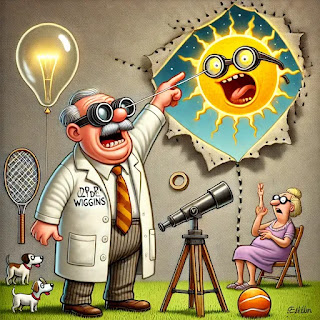Dr. Wiggins and the Cosmic Lightbulb: The Sun is a Hole-y Revelation!
Dr. Clyde P. Wiggins was not your average scientist. While most astrophysicists spent their days staring at telescopes and debating the fabric of spacetime, Dr. Wiggins spent his evenings muttering, "It's not a star. It's a hole!" in the break room of the Institute for Astronomical Studies. For years, his theory—that the sun was not a giant ball of plasma but rather a literal hole in the "sky fabric" letting light through from another dimension—had been the subject of ridicule. "Why does everyone think it's so crazy?" Clyde would ask anyone within earshot. "Have you touched it? No? Exactly!"
After decades of mocking glances and mysteriously lost grant applications, Clyde had finally had enough. He decided it was time to prove his theory once and for all. Armed with nothing but his wits, a budget-friendly telescope from Craigslist, and an old weather balloon he'd bought on impulse during a "Going-Out-of-Business" sale at Jerry's Party Supplies, Clyde hatched a plan.
The Experiment
Clyde's breakthrough came one Tuesday morning when, while scraping burnt toast, he noticed how light from his kitchen lamp seeped through a tear in the window curtain. "Aha! The exact same thing as the sun!" he exclaimed, terrifying his cat, Professor Whiskerton.
His experiment was simple yet audacious. He would send a probe—a contraption consisting of a GoPro duct-taped to a tennis racket—high enough to "poke" the sky near the sun and measure the resulting hole-y disruption. "If it works for curtains, it'll work for the heavens!" he declared confidently, ignoring the obvious differences between his drapes and the cosmos.
Liftoff
After months of meticulous preparation (and countless puzzled stares from his neighbors), Clyde’s balloon probe, which he lovingly named "SkyPoke-1," was launched from the local dog park. It soared majestically into the stratosphere, carrying its tennis-racket-mounted GoPro payload. Onlookers, mostly dog walkers, clapped politely, assuming this was some sort of art installation.
Clyde monitored the probe’s ascent nervously from a lawn chair, sipping lukewarm coffee and muttering calculations under his breath. As the probe neared the sun, Clyde's heart raced. "This is it!" he whispered to no one in particular.
The Discovery
Against all odds—and the protests of several FAA officials—SkyPoke-1 achieved its mission. At precisely 12:03 PM, as the probe reached a point just beneath what Clyde called "The Celestial Curtain," the tennis racket... hit something. The GoPro captured an extraordinary moment: the sun shimmered, flickered, and ripped slightly, revealing what appeared to be a massive floodlight from another dimension.
"YES!" Clyde screamed, startling a flock of pigeons and a woman pushing a stroller. "THEY SAID I WAS MAD, BUT WHO'S MAD NOW?!"
The footage was undeniable—or at least, that's what Clyde thought. As the rip sealed itself back up, the floodlight emitted a faint click sound, as though someone on the other side had just switched it off and on again.
The Aftermath
News of Clyde's discovery spread quickly. Some dismissed it as a hoax, while others believed he'd uncovered the greatest conspiracy in human history. Memes flooded the internet: "The sun is a hole and I'm whole-heartedly confused" trended for weeks.
The scientific community, reluctantly, began to take Clyde seriously after NASA accidentally corroborated his findings. During a routine solar observation, one of their telescopes caught a similar flicker in the sun, followed by what could only be described as a hand—yes, a giant hand—briefly poking through the rip to adjust the "lightbulb."
By the end of the year, Clyde's theory was accepted as fact. The sun wasn't a star; it was a tear in the fabric of the universe, patched together with duct tape and cosmic gum.
Clyde's Legacy
Dr. Wiggins became a global celebrity. He toured late-night shows, gave TED Talks, and even wrote a bestselling memoir titled, It’s Not a Star, You Fools!. His discovery raised profound questions about the nature of reality. What was the sky made of? Who was on the other side of the tear? And, most importantly, what brand of lightbulb were they using?
In the end, Clyde didn't have all the answers, but he didn't care. For the first time in his life, he was right, and the entire universe—or at least the ceiling above it—knew it.
As he liked to say in interviews, "The truth was always shining through. You just had to squint."




Comments
Post a Comment